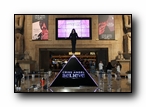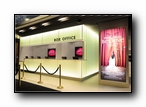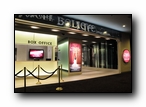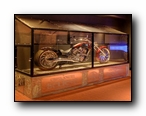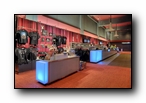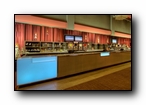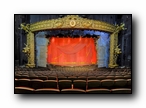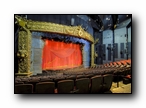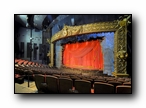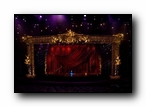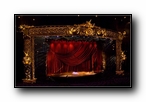
![]()
[ You are here: Grand Chapiteau | Creations | BELIEVE | Scénographie ]
Création
Expérience
Odyssey
Cirque du Soleil's sixth resident show in Las Vegas, Criss Angel Believe, was the mega-entertainment purveyor's first foray into magic — and first star-based effort — a departure from Angel's popular A&E Network TV program, Mindfreak. Making his debut with the company, director Serge Denoncourt worked with three Cirque du Soleil veterans, sound designer Jonathan Deans, projection director Francis Laporte, and Michael Curry once again providing puppets, masks, and kinetic props. Believe marked Cirque du Soleil design debuts for lighting designer Jeanette Farmer, set designer Ray Winkler, and costume designer Mérédith Caron.
Though no stranger to magic - Farmer cut her teeth on the lighting crew of Siegfried and Roy's magic extravaganza that ran for years at The Mirage – Believe is the first production for the 17-year veteran of Cirque du Soleil's lighting team in the role of lighting designer. “The lighting of illusions is actually a very technical and scientific process, although not as difficult as I thought it might be.” And Angel's illusions team was on board to help make sure the illusions worked within the overall aesthetic of the show. To create viable lighting positions in a venue that was a pretty straightforward Vegas-style showroom, Farmer added a 70'-long Front of House (FOH) lighting bridge. “This is well integrated into the room above the center cross aisle in the theatre,” she says. “I wanted some angularity to keep the lighting off of the RP screen.” Gear loaded onto the bridge, which became the principal FOH position, includes projectors, lighting fixtures, speakers, and followspots, as well the spot ops. The lighting system, a combination of new and existing gear, includes an Electronic Theatre Controls ETCNet2 Node networking system and ETC SmartSwitches for both 120V and 208V non-dim power. The dimmers include the theatre's preexisting eight Colortran/ Leviton i96 Series racks, with two new racks added to meet the needs of the show. “We took a chance and kept the existing dimmers, and upgraded how we deliver information to them,” notes Farmer. Control ranges from an ETC Unison architectural control system to four MA Lighting grandMA and grandMA light consoles — two used for lighting and the remaining two for special effects, including water, smoke, pyro, and flames. One large control booth at the back of the house comprises lighting, projection, special effects, and stage management. Automation is located in what Farmer calls “a condo position off stage right, on a deck above the stage itself for a better point of view.” PRG supplied the lighting system, with site project manager Jim Holladay supervising the installation along with an integration team from ETC and CDS project manager Alan Pilukas. Barbara Brennan and Jennifer Christiansen from PRG were the liaisons for the fixture package. “One of the challenges,” says Farmer, “was the integration of decade-old technology with state-of-the-art gear, as well as getting the grandMA network to talk to the ETC systems and the Leviton dimmers.” From the looks of things, the system certainly supports Farmer's design expectations. “The goal is to take people through many different worlds, such as a nightmare/dream world, and play with different time periods. It was challenging to play with the idea of time,” she says. “The show starts in the present tense with a cutting-edge magician and a rock ‘n’ roll feeling. Then right away, we take the audience back to a Victorian dream world.” Inspirations for the designs included drawings by Leonardo da Vinci and a Renaissance style, and Farmer did research into what theatre lighting looked like before gaslight. “The director had strong opinions about the visual aesthetic, and I was thrilled he had a specific vision for the quality of the show,” Farmer notes. “Having that goal in mind gave me a lot of room to experiment. We talked a lot about color and how it relates to emotion and how we might feel about something.” One of the design decisions was to use a different monochromatic palette for each scene. “It's as if the scenes are tinged with sepia, and you are looking at an old photograph,” Farmer adds. “Dance is also a key element, as this is not an acrobatic show,” she continues. As a result, one of Farmer's responses was to create the first layer of her rig as a traditional dance plot. “I cracked open Jean Rosenthal's ‘The Magic of Light’ and looked at classic lighting design for dance sidelight,” she says, noting that there is a constant of two-tone light on Criss Angel coming in from the sides. Storytelling also informed the shape of the rig. “The next layer is a theatrical rig with box booms and front washes to light surfaces,” Farmer adds. A third layer is in keeping with Angel's persona, allowing Farmer to create a rock ‘n’ roll feel when appropriate, blasting the artist and the audience with big beams in the air. The many layers result in a big rig (with a total of 1,500 fixtures), the architecture of which was in part influenced by color considerations. Here she uses more conventional fixtures than automated luminaires, with just 140 movers in the overall rig, laid out in advance using Cast Software Wysiwyg, with Proluxon in Montreal providing initial file preparation. Among the automated lights, she opted for Vari-Lite VL3500s for their framing shutters, while she found Martin Professional MAC 700 spots and washes “awesome for their size and amount of light output.” She also wanted “the ability to color correct toward Tungsten and avoid acid colors in the traditional looks by toning down the lamps and working with Martin on custom color correction to reach the color temperature of an ETC Source Four,” she says. “Martin also worked on the dimming profile and reworked the software for the dowser curve, so we could integrate the movers with the conventional lights' 20-count to black and take away the mechanical pop to black look.” Wybronscrollers add color on the conventional side of the rig. “The rig is big but really simple — nothing very ground-breaking,” says Farmer. “It is symmetric in terms of the conventionals and automated hang. Everything is very angular, with beam breakups from strange angles. It's all about non-symmetrical patterns and shifts from the symmetrical rig.” For followspots, Farmer also did some derring-do. She selected Robert Juliat followspots: two Victor 1,800W medium-throw spots on the FOH bridge and two Lucy 1,200W short-throw spots, one each integrated high up into the corners of the scenic proscenium. “My inspiration for that was partly from opera where they often use high, steep angles from the first electric. I like it for the angularity and how it fits with the aesthetic look.” Farmer then added an additional two LDR Canto 1200 followspots directly on the deck — one on either side of the stage — and operated by the deck electricians. “It is beautiful and unusual to be able to light people in ways you don't usually see them lit,” she adds. One of Farmer's favorite lighting looks is a moment when there are no upstage projections. “It's the scene with flames and smoke when Criss is going to be cut in half,” she says. “There is a large corrugated wall on stage. We put holes in the wall so we could blast bold light from behind in custom positions, with the light piercing through from the upstage back wall.” This was achieved by using a cluster of 19 750W ETC Source Fours and 40 ACLs. “That gave me the power I wanted with no color and strong white light to cut through the scene, with its ambers and reds for the flame effects. That was one moment when all the prep paid off, and everybody's jaw dropped in the theatre.” And sometimes powerful lighting is not required. In one of the most stunning scenes, a large field of red poppies appears on a projection screen, and Curry's prop-poppies fall onto the stage. “This one was tough,” says Farmer. “There is a floor of green silk and the red poppies and red dervishes on stage. You can't really mix red and green light together without an unwanted effect in this case, so I used two different angles and hung sidelights in odd positions as high as 20' from the deck to shoot across the stage. You never see the light land; you only see what it is lighting.” Additional lighting was built into Winkler's scenic pieces, the largest of which is the elaborate gold Baroque proscenium frame, which features a large clock at the top and a series of rabbits (the show's fetish animal), some 12' tall and some automated, pulling Angel's head out of a top hat. For the fixtures built into the proscenium frame, 18,000-hour MR16 lamps are used in TMB PAR20 fixtures treated with high-heat gold paint that allow them to be hidden in the proscenium frame.
Dressing trunks have Philips Solid-State Lighting Solutions/Color Kinetics ColorBlast 12s with radio control built in, and a bouquet in the wedding scene has light built in for a warm glow. There is also a real Tesla coil in a cage on stage. “The arc of electricity you see zinging around in the cage is real,” Farmer points out. “We had to keep the stage lighting low so you can see the effects of the coil, so we added fixtures in the cage to enhance the set and the coil, with a TMB Solaris Quasar 15kW Strobe adding big white flashes of light, like an electrical arcing discharge effect.”
According to projections designer Francis Laporte, the central concept of the projections in this show is to play with audience perceptions and create a kind of dialogue between the real and the virtual. Thus, the projections help shape the various environments of the show with a Gothic and Victorian flavor. The mysterious mixes with the grandiose, the bizarre with the sublime. Francis created a Victorian world around Criss Angel that is strange, but with an ultrachic side to it too, reminiscent of the world of Tim Burton and Terry Gilliam, with shades of the postmodern and a certain timelessness. It's a world Laporte refers to as “elegant, dramatic, mysterious, and twisted. We know we are looking at projections, and we don't try to fake it,” he says. “We are working in a theatrical aesthetic from an old, Italian theatre to sometime in 2008.” The surrealistic nature of the show required more composite 3D images, in contrast to Laporte's position that “he is still organic at heart — more of a painter than a computer person or graphic designer — but today, we have the tools to create my ideas.” His projections are designed to transform the entire atmosphere on stage by changing the image on the backdrop at the click of a switch. They help define the scene, to create the many moods of the show and support the many jumps in time throughout the story. “Sometimes I give a certain situation greater dimension by multiplying the elements of the story,” says Francis. “For example, for the cascade of poppies I created a vast field of poppies on a virtual turquoise sky. My ultimate goal is to give dimensions of perspective and depth. Sometimes I’m aiming for a passage from the virtual to the real, sometimes a passage from the real to the virtual – and at moments like that the projections are closely linked to the work of Criss Angel.” As a transition into the twisted, fantasy world, Laporte called upon the bunny motif, with a small white CGI bunny running into the “walls” of the projection screen as he tries to hop off stage. “It's a one-minute segment that took five or six people working like mad to please me,” he says. “I wanted it to be very realistic, and you can almost believe it's a real bunny.” In the duel scene, Laporte created an industrial landscape with factories, built in 2D using photographs, with smoke and flame effects added. “There is not too much color in this show,” he says. “The images create more discrete backgrounds. They are very big, but subtle.” Working with illusions was also new to Laporte. “It is challenging to create images in back of the illusions, rather than the traditional dark backgrounds in a magic show,” he says. “I went back to the masters of optical illusion to find ways to solve the situation. This is a theatrical show, with a narrative, as well as a visual show with illusions.” The projection system uses the theatre's fiber-optic backbone for video transport and includes 20 Christie Roadster S+20 projectors: three FOH on the bridge, 12 upstage for the 60-foot by 30-foot Stewart Filmscreen Aeroview 70 RP screen, and three on a custom shelf that project onto a 32-foot by 20-foot downstage Stewart Filmscreen LumiFlex 50/50 screen used for both front and rear projection. The custom, seamless screens are hung on counterweighted line sets and flown in and out as needed. There is also a live camera used at the top of the show to involve the audience intrinsically in the action. The final two Christie projectors were adapted by Tom Juliano, projection systems project manager for Believe, who redesigned them into custom, manually-operated projectors, nicknamed the “gunny” projectors. In order to use these like spotlights, each one is mounted on a Vinten Vector 950 fluid head to support the 200lb weight of the projector and provide smooth pan and tilt, with an AMX interface for zoom, focus, and shutter control via a custom joystick. “These are really ground-breaking,” says Juliano, who is proud of his invention. (A local company, Spencer Technical, took his idea and built the hardware.) Image playback is via 12 Green Hippo V3 Hippotizers, located in a rack room next to the control booth and using PC-based Zookeeper control. Nigel Sadler of Green Hippo helped with installation and tech support. As the images were more high-tech than Laporte usually provides, Juliano set up an HP/CalDigitHDPro four terabyte render farm for custom content creation. Images were composited using photographs and computer-generated images using such programs as Maya, Adobe Illustrator, Photoshop, and After Effects. In terms of the projection challenges, there is only a 30-foot throw behind the large RP screen, so Christie's new short-throw lenses are used. (Solotech provided the video gear package.) For staging and programming of projections, Juliano notes that an Evertz MVP Multi-Viewer system was installed to allow programming and operation of each output of the Hippotizer servers without ever turning on a projector. The MVP places tiled video frames onto two Sharp 42" HD LCD monitors mounted in place above the operator.
As with other audacious Cirque du Soleil productions that push the limits of artistry and technology, sound plays a critical role in CRISS ANGEL Believe. With a Meyer Sound loudspeaker and audio show control system provided by Solotech, veteran Sound Designer Jonathan Deans immerses the audience with a surreal and dynamic aural environment of a haunting netherworld."The show is all about Criss Angel and his illusions," says Deans. Composed by Eric Serra, the music in CRISS ANGEL Believe is supported by a 152-input Matrix3 audio show control. A CueConsole modular control interface is employed to manage front-of-house functions, with system outputs routed to a total of 99 self-powered Meyer Sound loudspeakers. SpaceMap multichannel surround panning allows the designer to accurately place the sound where desired. The Meyer Sound system delivers an arena rock sound for the opening Mindfreak number, and then seamlessly switches to a surround Cirque style of sound. "This required extensive surround speakers, creative bussing, and some complex SpaceMap panning," says Brian Hsieh, Deans's associate. "Also, the music is dynamically varied, ranging from club-like rave to orchestral and operatic." The third key member of the audio production team, Head of Sound Rob Mele, finds the Matrix3 system an ideal platform for mixing the multilayered music as well as for managing the stringent timing demands of an illusion-based show. "The music works very well with a layered and textured environment," Mele notes. "The effect really encompasses you, and brings you fully into the show."
To accommodate these requirements, Hsieh employed 20 different SpaceMap trajectories. He also made extensive use of the Matrix3's timecode facilities to trigger cues, and programmed the system to respond to external triggers from the projection system.A range of Meyer Sound loudspeakers are connected to the Matrix3, either directly or—as with the M'elodie and MICA line arrays – via a Galileo loudspeaker management system. The loudspeaker configuration encompasses multiple subsystems for voice, music, and surround/effects. In addition to the four arrays of six M'elodie loudspeakers each for voice, two arrays of ten MICA loudspeakers for music, and six 700-HP subwoofers, the complement includes M1D line array loudspeakers, CQ-1, CQ-2, UPM-1P, UPA-1P, and MTS-4A loudspeakers, as well as SB-2 parabolic wide-range sound beams. The six SB-2 sound beams, deployed three on each side of the theatre, play a critical role in developing the highly localized and multilayered sounds demanded by the production. At one moment, the audience gets a distant, open sound from the CQ-2 loudspeakers placed below the sound beams, and an instant later the sound pans into the SB-2s and it moves in right next to the viewer. According to Mele, this creates an extraordinary effect that provides another layer of sound for greater complexity. “The amount of soundscaping has to create a global sound, not point-sourced away from the stage, as that can be distracting from the focus on Criss. The audience has to focus on the illusions.”The rig, which Deans says is budget-conscious and straight forward, did have to meet the needs of certain scenes, such as Angel hanging upside down over the audience. Deans describes the ambiance as “very techno, like going to a rave. We need a lot of sheer power in the auditorium.” Ultimately, the rig can be used to focus when a point source is needed, but that was not the main design criteria. The surround system, however, is present constantly as part of the overall experience. “The sound is very layered and involved but focuses you to the stage,” says Deans. “We still treat the sound as you would expect with Cirque du Soleil, but you focus on the visual images rather than the music.”
The Luxor Theatre is configured in a classical proscenium layout. Early in the creation process director Serge Denoncourt decided he wanted a traditional theatrical approach to the show that would be very far from a Vegas pastiche. In terms of the Luxor Theatre, the redesign was fairly extensive, although it does not have the “wow” factor of the environments created for other Las Vegas-based Cirque du Soleil shows. “The goal was to take an existing theatre and leave it pretty much as it was,” says Farmer. But as the new show's needs developed, the 1,600-seat theatre proved to need more than a simple facelift and underwent “a gentle renovation.” The seating configuration was redone, with wider, more comfortable seats and better sightlines throughout. Trizart Alliance served as theatre consultants in conjunction with CDS lead Ray Forton. In order to add the FOH bridge and the gold proscenium frame, as well as other elements for the show, extra steel had to be added to the roof structure, which had not been built to support such extra weight. There were also major acoustic adjustments made by JaffeHolden Acoustics. “It was an existing facility with many acoustic problems, including multiple echoes off the back wall, and a noisy HVAC system,” says lead acoustician Mark Holden, who adds that there were smoke hatches on the roof that made noise when the wind blew. “It was like dropping a plane on the roof.” Working with Pierre Lemieux from Trizart, acoustic improvements were done to make sure the response time was up to Cirque du Soleil's standards. “We tested and measured and came up with three treatments,” says Holden. First, thick absorption panels were added in select places to control the echo from the rear wall. Secondly, reverb time was controlled by surgically adding acoustic panels where needed. “We told them not to cover all of the side walls for fear of making it too flat,” Holden adds. “We did computer modeling and ray drawings to make sure we left enough energy and life in the room.” The ceiling of the room was also treated in an unusual way, by adding a certain density and thickness of fiberglass above the old gypsum board ceiling to make it work better acoustically. “We made it a bass absorber tuned to suck up the bass in the room and reduce the boom,” Holden explains. “Jonathan Deans likes strong bass, loud and with impact, but you want it to die quickly, so the ceiling became a bass trap.” The third major improvement was to reduce the noise from the air system, partly by reconfiguring a duct that was roaring away near the edge of the stage. “We got rid of a lot of noise,” continues Holden. “The room can now be tightly controlled acoustically to handle loud and soft sound. It is flat, with no echoes but still has energy. You can get a great dynamic range.” “The challenge was to incorporate magic and illusions into the set elements,” says set designer Ray Winkler. “It was interesting to learn about the techniques of illusion. Criss Angel has to put in considerable effort to transcend the technical constraints and present his magic with apparent simplicity.”
Winkler, who is a designer at Mark Fisher's Stufish in London, notes that the scenic aspects of Believe “create a weird world of surreal references, mixing styles and genres into a unique setting,” to support the illusions. This weird world begins with the large gold proscenium frame, built by Calgary-based F&D Scene Changes, which sets the tone for the entire production. The creation of the Gold Frame involved the talents of 30 sculptors, moldmakers and painters over a period of three months. There are seven rabbit characters on the carved gold frame, the largest, the center clock rabbit, measures 10’00” x 10'06”. “The set had to complement the magic performances, be subservient to their very stringent demands, and provide an environment for the magic that worked technically and was stylistically interesting,” he says. |


